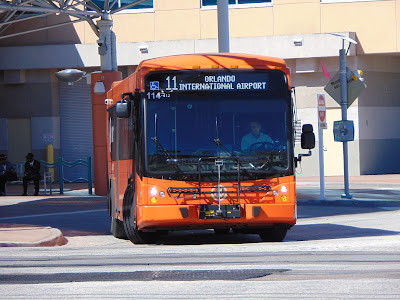REVIEW: Lynx's Free Wi-Fi Service
We broke the news back in November that free Wi-Fi internet service would be coming soon to Lynx buses, and in early January, Lynx installed the necessary equipment on its' 300 bus fleet and turned on the service for passenger use.
I tried it out over several rides the past two weeks and came away mostly satisfied with the free service.
Speed
Overall, the speed of the internet connection felt similar to 3G cellular internet, or slightly slower than my home Wi-Fi and considerably slower than 4G cellular. It was acceptable given the nature of the service (on a moving vehicle) and the price point (free).
The speed and connection was generally consistent, with one exception where the service slowed to a crawl and a web page took nearly 5 minutes to load.
High-bandwidth uses, like most streaming video, Skype and downloading/uploading large files were blocked, though I was able to get a few shorter, non-HD video clips to play.
Obviously, speed will be affected by the number of users, and as the service grows in popularity, it's quite possible that speeds will degrade to an unacceptable level. I observed a few others using smartphones during my tests, but it's unclear if they were connected to the Lynx Wi-Fi.
Connecting / Ease of Use
While the speed of the connection was acceptable, connecting to the service was not the most user-friendly process.
After scrolling all the way to the bottom and clicking the "I Agree to Terms" button (though the text directly above the button tells you to click "I Agree with Policy"), at least half the time I received an error message that "Hotspot login cannot open the page because too many redirects occurred," although I successfully connected every time even if I received the message.
On one occasion, I received a "Hotspot service not available" message, but was able to connect by disconnecting and rejoining the Wi-Fi network.
Lynx promised that inappropriate web sites and content would be blocked by the service, but they took it one level too far.
A porn site was appropriately blocked, but so was the Florida Lottery web site when I attempted to access it to check my tickets against winning numbers from the previous night's drawing. There's no opportunity to actually gamble on the Florida Lottery site, so the block seems unnecessary.
While there is a button that promises to "Report an inaccuracy" on the block screen, nothing happens when I pressed it to report the lottery site, so it's not clear if a report is filed or any other action was taken.
Creating Awareness
There's a sign next to the front door on most Lynx buses (I expect the rest will receive the sign in the near future), and both the enunciator and LED screen inside the buses periodically tout the availability of the service in both English and Spanish. There were also signs throughout Lynx Central Station in Downtown Orlando.
Overall
Lynx does not have to offer complimentary Wi-Fi on the buses, so the fact that they've decided to roll-out this customer amenity is impressive. Given that the service is reliable and the speed is acceptable, it deserves a solid 4-star rating. We hope that they can make the process of connecting to the service a bit less clumsy in the coming months so the less-than-tech savvy can have an easier time.
I spend a lot of time on Lynx buses, so this service will likely allow me to reduce my cell phone data plan and save at least a little bit of money. I'd imagine there are many other riders who will be able to do the same.
Have you tried the new Lynx bus Wi-Fi? We want to hear from you! Tell us what you think by emailing LynxedTogether@gmail.com








